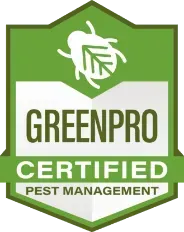What Are Jumping Spiders?

The Salticidae, or jumping spiders, are one of a number of types of spiders that instead of building webs, hunt or stalk their prey. With more than 5,000 species worldwide, 300 of which are found in the United States and Canada, they are the largest known family of spiders, making up 13% of the world’s spider population. Given these numbers and that they are active during the day, it’s not surprising that encounters with them throughout the United States, including Utah, occur frequently.
What Do Jumping Spiders Look Like?
Jumping spiders are a fascinating species with unique physical characteristics and abilities. Here are some key points to know about them:
- Jumping spiders come in a variety of colors, including black, brown, tan, and gray, with markings that can be white, gray, yellow, red, blue, or green.
- They have compact bodies and relatively short legs, with the front legs being the thickest and longest.
- Jumping spiders have rectangular faces, often with a furry appearance, and 8 eyes arranged in 4 pairs, with the largest pair located in the middle of the forehead.
- These spiders have exceptional vision, which allows them to accurately judge distances, identify potential prey, and find possible mates.
Female jumping spiders tend to be larger than the males, but the most obvious way to differentiate between the sexes is the presence of visible reproductive organs. The clear, shiny spot on the underside of a female, called an epigynum, which is where males place sperm packets for use at a later date. Males have a visible thickening at the ends of the palps, which look like little boxing gloves, to store and transfer these packets after enchanting a female spider with a courtship dance. In some species, markings can vary based on sex, but there can be exceptions, so it’s best not to rely on appearance alone.
What Do Jumping Spiders Eat?
The jumping spider is a formidable daytime hunter, using its excellent eyesight to spot its prey. Spinning a silk safety line, they then leap onto the unsuspecting victim, grasp the target with their powerful front legs, and incapacitate their meal with a venomous bite. Jumping spiders do not use webs to catch their food, they only spin a silk line as a tether when leaping or as a shelter for mating, laying eggs, and nighttime protection.
Although they occasionally drink nectar from plants, the diet of a jumping spider consists mainly of insects and bugs such as:
- House flies
- Fruit flies
- Moths
- Butterflies
- Bees
- Crickets
- Grasshoppers
- Worms, mealworms, and wax worms
What are the Types of Jumping Spiders?
With 300 species of jumping spiders spread throughout the United States, each state is home to at least one type. A few of the number of varieties that can be found in Utah are:
Phidippus Audax
Found in all 50 states, one of the most commonly seen jumping spiders in Utah, Phidippus audax, or the daring/bold jumping spider, is known for its ability to jump up to 50 times the length of its body, which is around a yard. At about ¾” in size, they are black with 3 distinguishing marks on the abdomen, which are orange when young and gradually turn white with age. Its most unique feature are its fangs, or chelicerae, which have a metallic green hue. It is often misidentified as a male Regal Jumping spider, which has similarities in coloring.
Phidippus Johnsoni
Phidippus iohnsoni, or the red-backed jumping spider, inhabits the Western US, west of the Great Plains, and is easily identifiable with its black body and brightly red-colored back of the abdomen. The male is smaller with a solid red back, while the female has a black stripe down the center of the abdomen and the possible addition of small yellow or white dots or a thin yellow or white line surrounding the red area. One of the larger jumping spiders, they range in size from 0.25”-0.55” with relatively short legs. It is often confused with Phidippus carneus.
Phidippus apacheanus
More commonly known as the Apache jumping spider, Phidippus apacheanus is found primarily in the southern United States in areas of grasslands, prairies, plains, dry fields up to about 6000 feet in elevation, and the sagebrush flats in Utah. Often around 0.4” or longer, these creatures are primarily black with a bright scarlet coloring on the dorsal side of the cephalothorax and abdomen of male spiders. Females are more orange and their abdomen may have a central black area and there may be red or orange rings down their legs. Their appearance resembles that of mutillid wasps, otherwise known as velvet ants, which are vicious wingless wasps that live in the ground.
Why Are They Called Jumping Spiders?
The members of the Salticidae family get the name jumping spiders from the ability to propel themselves, or jump, in pursuit of their prey and to move in general. Increased blood flow to the rear legs causes them to fully extend, propelling the spider into the air. On average, these creatures can jump 20 times the length of their body. If humans had that ability, a 7-foot-tall NBA player would be able to dunk a basketball into a net on the side of a building 12 stories up or cover 1.4 football fields in a single bound.
Where do Jumping spiders live?
Jumping spiders can be found on 6 of the 7 continents, with the exception of Antarctica. They have been spotted in every climate, including tropical forests, deserts, mountainous regions, and more, including on the slopes of Mt. Everest. Of the 300 species found in the US, one species or another is present in every state and it is the most common type of spider you will find in many places, including Utah. They seek shelter in tall grasses, dense vegetation, underneath loose bark, and in other areas that offer protection.
Where Do Jumping Spiders Hide in Your house?
It’s unusual to find jumping spiders in your home, but when you do, they more than likely entered through wall cracks and holes in screens or were accidentally carried in with other items. During the day they can be found near windows and doors where hunting conditions are most suitable and at night they find resting places under furniture, in cracks, behind window and door trim, and between items that give them shelter, such as books and boxes.
Are Jumping Spiders Dangerous?
In most cases, jumping spiders will run away before biting you. Only when they are threatened or crushed will they attack. Although jumping spiders do produce small amounts of venom, their bites are typically not considered dangerous to humans. Recommended home care of the bitten area includes washing with soap and water, applying cool compresses to reduce swelling and discoloration, and use of a topical antibiotic ointment. However, as with any spider bite, there is a chance you could have an allergic reaction, so if you experience nausea and vomiting, a spreading rash, difficulty breathing, or other severe symptoms, you should seek medical attention immediately.
What to Do if I See a Jumping Spider in My Home?
If you see a jumping spider in your home, there is no need to panic. They are probably more afraid of you than you are of them. They don’t intend to harm you and will not stay if there is nothing to eat or if you don’t have a space in which they can find shelter. To achieve such an environment, remove clutter to eliminate hiding spaces, seal entry points to keep out other pests, and regularly sweep and vacuum. If they keep returning, help from a professional may be necessary to get rid of jumping spiders for good. Locally owned and operated, Western Pest Control has 20+ years of experience eliminating all types of spiders and the pests that attract them using effective eco-friendly and EPA-approved products. Contact us today to experience our quality pest control and outstanding service in Southern Utah.


